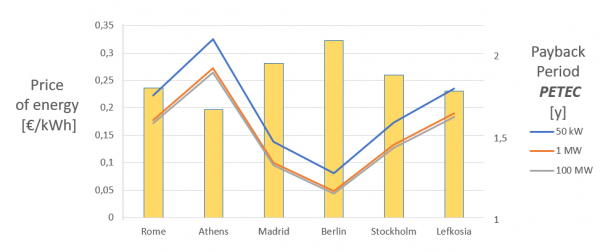This document initially presented three possible configurations for this type of technology based on the plant size (50 kW, 1 MW, 100 MW), each most suitable for a certain capacity and a particular branch of application.
Subsequently, the tools were presented, thanks to which it was possible to compare TECSAS technology with the state-of-the-art systems, and thus the technical model and the economic model: the former allowed us to identify, for each temperature, the material, via the physical property of work function, that ensured the best energy efficiency, while the latter was used to assess the impact on costs and revenues that each type of configuration at each scale studied could have, and thus how much they were actually worth, also assessing the different geographical location.
Finally, thanks to the numerical values obtained from the models, a discussion was carried on regarding the business cases of this technology, thus considering the most suitable configurations and scales for each application in order to optimise efficiency and show how much better TECSAS technology is potentially than current technologies.
Thanks to this study, the qualities of TECSAS technology have been made evident. It has excellent market possibilities, having been compared with its current main competitor, PV, and having been found to be more cost-effective, in particular for small scales. In fact, we have explained how its compactness and efficiency would make it the preferred state-of-the-art solution in this field, associated with low installation costs and practically zero operating costs, having a low payback time and thus soon becoming a source of profit.
On larger scales, in the absence of a suitable model that could reliably scale the data, it was not possible to reconfirm with certainty the convenience of this technology over the others, although an outline study has brought positive results, which nevertheless need reliable numerical confirmation.
In conclusion, the absolute versatility and wide assortment of configurations that characterize the TECSAS technology make it a competitive technology in the CSP business field that is likely to increase its portion of the market among renewable energy sources, which are already rapidly rising in themselves.
Summary of Deliverable 2.2: Business Cases for the Various Application Scenarios
01 Giugno 2022
Publications
© Copyright 2021 - TECSAS Project


